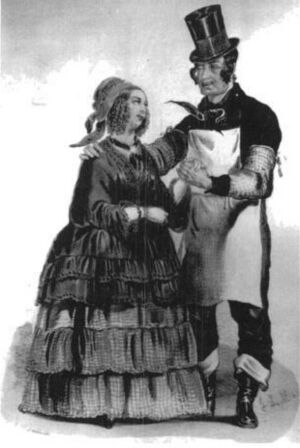B'hoy and g'hal facts for kids
Have you ever heard of a "b'hoy" or a "g'hal"? These were popular slang words used in New York City in the 1840s and 1850s. They described young working-class men and women from Lower Manhattan. The words sounded like the Irish way of saying "boy" and "gal." These young people had their own special slang, using phrases like "hi-hi" and "cheese it."
Contents
What Do B'hoys and G'hals Mean?
The word "b'hoy" first appeared around 1846. In the United States, it was a common way to describe a "spirited lad" or a "young spark." This word came from the Irish way of pronouncing "boy."
B'hoys and G'hals in Plays
The most famous example of a b'hoy character appeared in a play in 1848. An actor named Frank Chanfrau played Mose the Fireboy in a show called A Glance at New York. Mose was a tough Irish volunteer fireman who liked to fight.
Mose the Fireboy's Look
Mose had a very specific look that many young men copied. He wore a red shirt with his fire coat over his arm. He had a tall "stovepipe hat," also called a "plug," pulled down over one eye. His pants were tucked into his boots. A cigar stuck out from his lips. His hair, called "soap locks," was plastered flat on his temples. He often had a determined look on his face.
Other b'hoys in plays might have different names like Sykesy. Some were even butcher's apprentices. Another description of a typical b'hoy included:
- A tall beaver hat with the fur brushed in opposite directions.
- Hair clipped short at the back, but with curled and greased "temple locks" in front.
- A smooth face.
- A bright silk scarf around his neck.
- A black coat and wide pants.
- Heavy boots made for tough work.
When a b'hoy was dressed like this, with his g'hal on his arm, it was best not to bother him!
Lize, the G'hal
Mose's girlfriend, Lize, was the perfect example of a g'hal. She wore inexpensive but fancy clothes. She also loved to sing songs from her favorite minstrel shows.
Popularity of the Plays
Plays about Mose became hugely popular in New York and other big cities. Theaters were packed with b'hoys and g'hals who wanted to see Chanfrau and other actors play these characters. One writer even noted that the audience at the Olympic Theatre changed completely. Instead of the city's fancy people, the theater was filled with b'hoys everywhere – in the pit, the boxes, and the gallery. It seemed like "Mose" was everywhere!


